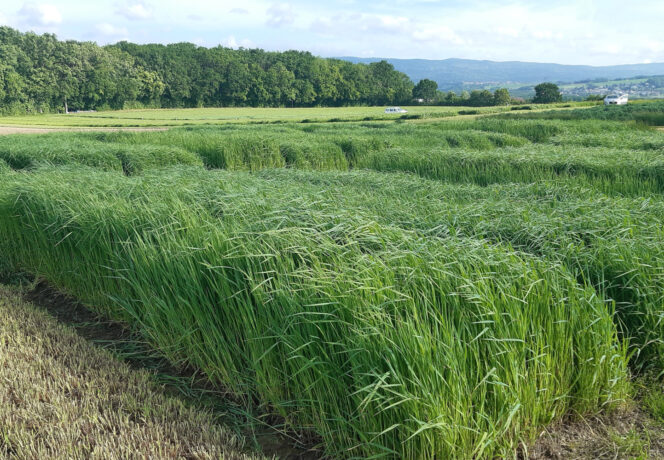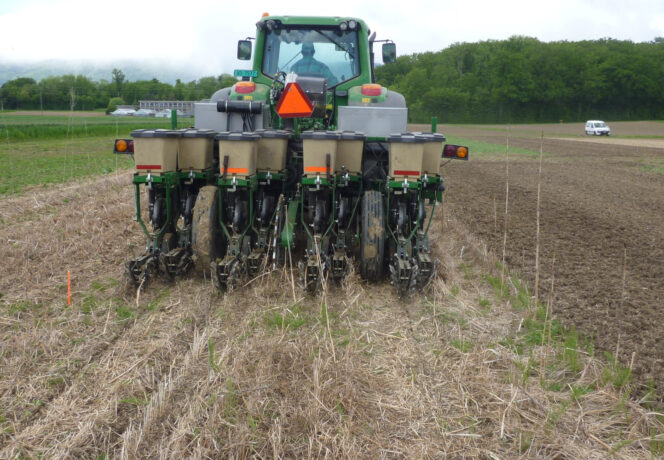Japanese Beetle: Damage Potential and Control Measures in Switzerland
Photo: Tanja Graf,
Agroscope
Agroscope researchers have assessed the potential impact of the Japanese beetle for Swiss agriculture and outlined integrated, multi-crop control measures for different sectors of production.
The Japanese beetle (Popillia japonica) is a priority quarantine pest (PGesV SR 0.916.20) native to Northeast Asia that arrived in Switzerland in 2017. This scarab beetle infests more than 400 species of plant and has very high damage potential for Swiss society and agriculture. Both adult beetles and their larvae damage crops, although they infest different plant species and their habitats are spatially distinct. The larvae prefer to feed on grass roots, whereas the adults eat the leaves, flowers and fruits of a wide variety of herbaceous plants, shrubs and trees. The accidental introduction of the Japanese beetle presents the Swiss Federal Plant Protection Service, the cantonal agencies and the agricultural sector with one of their greatest phytosanitary challenges of recent years. Based on a study of over 130 publications, researchers of Agroscope have assessed the damage potential of the beetle for arable, vegetable and fruit production, viticulture as well as grasslands, and compiled preliminary phytosanitary measures.
All sectors of crop production are at risk
Adult Japanese beetles damage the fruits of a wide variety of fruit crops, especially berries, cherries and apricots, as well as the leaves of grapevines, vegetable, fruit trees and arable crops. The larvae infest irrigated lawns such as sports grounds, golf courses, turf growing facilities, public parks and private gardens.
Effective crop protection is achievable
The Japanese beetle is a priority, controlled quarantine pest, which means that official regulations concerning its eradication or containment must be executed. However, in the long term it is vital to establish effective, integrated and sustainable phytosanitary strategies comprising different preventive, mechanical, biological, biotechnical and chemical control measures. The main priority is to prevent the accidental introduction of larvae and adult Japanese beetles. In addition, egg laying and larval development in the soil can be limited by reduced irrigation. Targeted tillage and covering of the soil can help reduce larval infestations. Larvae can also be controlled directly with nematode treatments, while nets provide effective protection against adult Japanese beetles. Leaf damage can be reduced by applying stone powders such as kaolin to the foliage. It seems unlikely that the use of insecticides against Japanese beetles can be completely avoided. However, the quantities used and the amount of spray residue on the harvested crop can be reduced to a minimum through the use of attractants (for example with spot spraying, mass trapping or long‐lasting insecticide‐treated nets). The estimated importance of these control measures for different production areas is summarised in a table and crop-specific integrated phytosanitary control strategies can be deduced. In addition, Agroscope is working intensively on other promising biological control measures. However, it will take time to bring these natural biocontrol agents to market readiness and overcome the regulatory hurdles.
Conclusions
- Japanese beetles have very high damage potential, as they affect many agricultural crops and are expected to cause serious damage to public and private green spaces.
- Vulnerable ripening crops close to larval breeding grounds such as grassland and irrigated green spaces are most at risk from adult Japanese beetles.
- A combination of different control measures is needed for effective integrated plant protection. Since larvae and adults are spatially separated, it is not enough to control individual locations. An integrated, multi-crop approach at landscape level involving all stakeholders is the only effective way to protect crops.
Bibliographical reference
Schadpotenzial und Bekämpfung des Japankäfers in der Schweizer Landwirtschaft.



